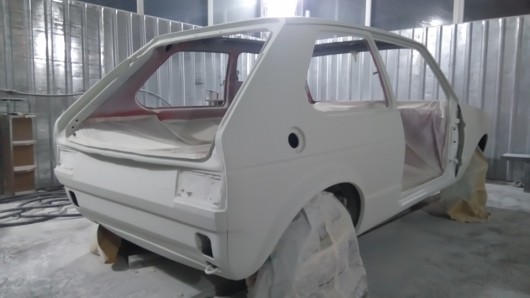
Puttying a car - lessons for beginners
Content
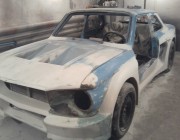 Many car owners sooner or later face the issue of applying putty, because there are no ideal materials that would never wear out.
Many car owners sooner or later face the issue of applying putty, because there are no ideal materials that would never wear out.
The body can be both scratched during an accident and hurt something, but you can’t hide from the weather at all, as well as from the appearance of rust, therefore, in order to eliminate defects on the body, this material is used.
This article should serve as a kind of guide to working with car putties for beginner painters and those who just love their car and do everything themselves.
The principle of puttying, purpose
It is important to approach the issue of puttying seriously, because this stage directly affects the shape of the body and the quality of painting, applying the appropriate layers. This procedure is phased and takes a lot of time, it is necessary to prepare for it.
Each car owner, one way or another, will face the issue of puttying - if you get into an accident, get a dent on the bumper, the appearance of rust on the body.
Body repairs cannot be carried out without puttying. Sometimes this time-consuming process needs to be learned.
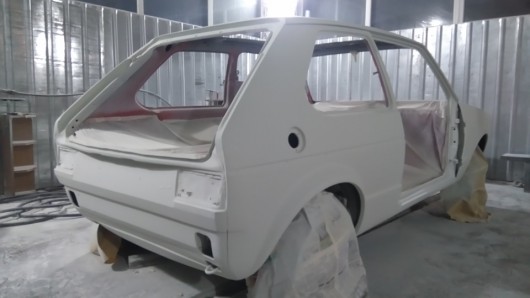
An ideal result can be achieved only with some experience in this procedure. Engagement putty to level the surface, so it will have to be applied in a fairly large layer. The more evenly the layer is laid, the less work will have to be done later on grinding the surface of the car.
Depending on the purpose, the material has a different composition. Most putties are two-component. As fillers can act: chalk, talc, metal powder and much more.
Main binders:
- Small shrinkage, good adhesion of the material is provided by polyester resin;
- Epoxy resin is less workable, but ideal for plastic applications, it is quite toxic.
It is important that the material you choose for the work is applied evenly, can be applied to the required areas, quickly hardens, and is easy to apply.
So you make it easier for yourself to carry out all the work and at the same time achieve the desired result. Remember, patience and compliance with the entire technology of applying the material is important.
But by what criteria to choose the best material, consider the types of putty presented.
What does putty consist of, types
There are several types of putties on the market today. Each of them meets a number of criteria and is used in individual cases.
At first, it must have high-quality connecting characteristics with a competently processed area.
Secondly, the solution must be evenly laid on the surface of the machine.
Thirdly, putty should have excellent shrinkage, and this is possible with high-quality material.
In this procedure, not only the material is important, but also the high-quality processing of the body. The mixture you choose should be compatible with the future paintwork.
There are such types of putties:
- Coarse putties are applied only if serious defects form on the body - swept, cracks. The composition of such a material often contains some kind of filler, for example, chips.
- This material has a number of features - easy grinding, withstands high temperatures, very elastic, which allows you to level large surfaces.
- Fiberglass putties are very durable. Upon application, the solution transforms into a layer of hard fiberglass, which is perfectly sanded. This material is ideal to cover holes formed from corrosion.
- Thin fillers are used to repair minor damage, such as scratches. The final stage of puttying is carried out with this material. These include fine and nitro putties, which are then easily processed.
- Liquid materials are applied by a device - a gun, but this results in the most even layer. It takes a few hours for it to dry.
- Universal putty acts as a replacement for the above options, you definitely won’t go wrong with it. At the same time, it is durable, has a uniform structure and is easily processed.
Owners of older cars often use thermoplastic acrylic varnish, it is not compatible with all putties, for this you need to read the instructions.
Some manufacturers try to produce paints and putties that are compatible with each other. Be sure to follow the instructions, try to learn these acts in advance, which will save time and money.
Putty also differs depending on the type of base:
Nitrocellulose putties, where most of it is dry matter, therefore it is used to eliminate minor defects. Such a base can dry in a few hours at room temperature. Since the composition contains solvents, they are toxic.
Polyester putties - the best option to eliminate defects in the car body. They are easily leveled and only at room temperature can dry within an hour.
Acrylic putties created with the latest technology, therefore environmentally friendly. There are no solvents in the content, the material dries instantly. It is used to eliminate deep pores.
It is important to use and combine mixtures correctly. For example, if you combine them with a hardener, the coating will be damaged and work will have to be started from the very beginning.
Therefore, it is difficult to say exactly which putty is best suited, it is necessary to take into account all the circumstances. How putty dries depends on its composition.
For example, if a hardener is added to a two-component putty, it will dry faster - in half an hour, while the work will have to be done faster.
Epoxy putties will dry for a day at room temperature.
To reduce drying, many use hot drying. But this procedure must be carried out carefully, maintaining the putty coating at room temperature.
To carry out all work, it is necessary to stock up on a mask, glasses, special clothing. Such material is safe, only dust that can get into the lungs during grinding is harmful, so it is worth considering protective equipment.
How to prepare a surface for puttying
Decide on the place of painting and start cleaning this surface. It is best to use a solvent that will help degrease the body parts.
Remember, putty does not overlap with gloss, which is why stripping work is so important. Many people run an orbital sander for this.
If the places are hard to reach, then you will have to get to them on your own, stock up on sandpaper. If you see a manifestation of rust, then these places must be smeared with a converter.
Only after that you can begin to create the basis of the machine, its appearance will depend on it. Dilute the coarse putty with a solvent, because it must be applied first.


Watch this video on YouTube
You do not need to immediately begin to eliminate the defect, it is better to apply putty in several layers, waiting for the first one to dry. Work must be done quickly and confidently, because the material begins to harden after 5-10 minutes.
If your putty has begun to harden, and you don’t like something, you shouldn’t level it, the situation will only worsen. Stop work, wait until it dries, and use the tool to remove the remaining putty.
If you don't add enough mix, it will simply not set in the right places, which will have a bad effect on the next surface sanding procedure.
You must understand that the evenness of the paintwork directly depends on the work done on puttying. The better the material is fixed on the body, the longer the subsequent layer applied to it, namely the paint, will last.
The thickness of the layer depends on the recommendations of the manufacturer, try to follow the instructions. Someone recommends applying a layer of 1 mm, and someone 3 mm or more, it all depends on the composition and level of damage.
For example, when applying liquid putty, a layer of 100-500 microns is formed. This issue must be approached individually.
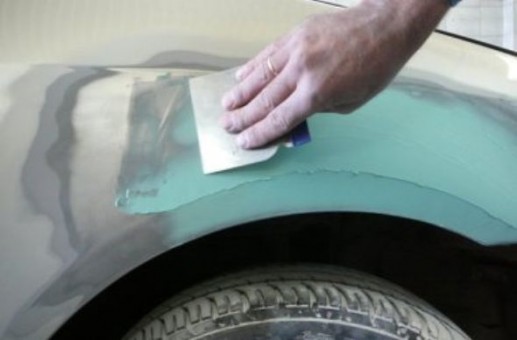

Many craftsmen can afford to apply more material when they see it is necessary. Often this can be done, the main thing is that this does not affect the strength of the repair.
Violation of the recommendations in this matter may lead in the near future to its detachment from the body. The cause of delamination can also be a violation of the temperature regime.
According to the recommendations of many manufacturers, work must be carried out in a temperature range up to + 50 ° C. The better you perform the work on applying the putty, the less time you will have to spend on the grinding procedure.
Putty works
Puttying procedures are divided into draft and finishing. If there is significant damage on the body, then it is still better to entrust the work to the leveler so that the material applied by you does not turn into a real crack.
The rough layer should be applied with coarse putty, all work is done with spatulas, it is also used to create the mixture. The more thin layers of material, the less chance of blisters and dips, so be patient.


Watch this video on YouTube
The rough layer is ground with fine-grained and medium-grained sandpaper. Your surface should become smooth without transitions and joints.
Use a ruler, attaching it, you will immediately notice all the bumps. Subsequent layers are applied in the same way until the desired effect is achieved.
Fine-grained putty will be used at the final stage. Processing can be completed with a grinder or abrasive wheels.
The material used at this stage does not require mixing and adding other substances. Due to the high shrinkage rate, such material must be applied in a thin layer.
When carrying out work, it is necessary to observe technical points, as well as listen to the recommendations:
— when purchasing material for work, you should pay attention that it is divided for professionals and amateurs. The latter is suitable just in our case.
— before you buy the material, read the instructions, which will show if preliminary priming and painting is necessary.
— in order not to confuse with the addition of a hardener, many use a special dispenser and rent a dispenser. The exact combination of ingredients will help save on material and form the right coating.
— do not use cardboard as a material for the preparation of putty, this may affect the composition, because its components may fit.
— rust removal is an important procedure that should not be missed. Rust can be removed with a brush attached to a drill, which will greatly speed up the process.
After treatment, apply to the required areas with rust converters. In this case, the work must be carried out with gloves. After removing the transducer from the call, it will not do without a degreasing and puttying procedure.
— use a special rust remover that turns rust into dark spots that are easier to process later.
What mistakes beginners make
In order to carry out the work correctly and achieve the proper result, it is worth following the instructions clearly, choosing the right material and listening to some recommendations.
Beginners are often in a hurry and manage to create problems that are harder to fix than to coat.
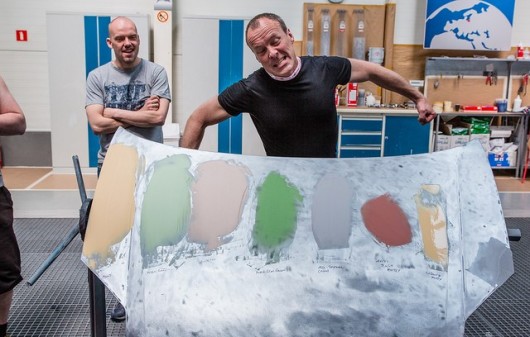

It is important to remember and follow these guidelines:
- carry out all work on a dry surface, because moisture forms corrosion, which corrodes the surface. During preparatory work, when you wash the car, let it dry thoroughly;
- putty cannot be laid on a glossy surface, it will simply peel off. Degreasing, cleaning and only then applying a layer of putty.
- two spatulas are used in the work - for applying large and small putty.
- before each application, stir your mass, because thick components form at the bottom, and resins form on top.
- draw up a work plan for yourself, describe at what stage and what materials will be used, then you will definitely not confuse anything.
- do not add a hardener to the jar with putty material, try to follow the proportion indicated in the instructions;
- many interfere with a larger amount of putty, and then remain without material, because they forget that the material hardens in 10 minutes. During this time, it is impossible to process all areas, so divide the material.
- hold the spatula at a 60 degree angle.
- acid soil, primer-filler is used in areas with corrosion, which cannot be left without treatment just like that.
- to avoid the appearance of pores during the application of the material, the material should be thoroughly mixed.
Puttying a car is a very laborious process, especially if you decide to do it yourself.
It is important to take this issue responsibly and do the work calmly and confidently, this is the only way to achieve a perfectly flat surface, on which paint is then applied.